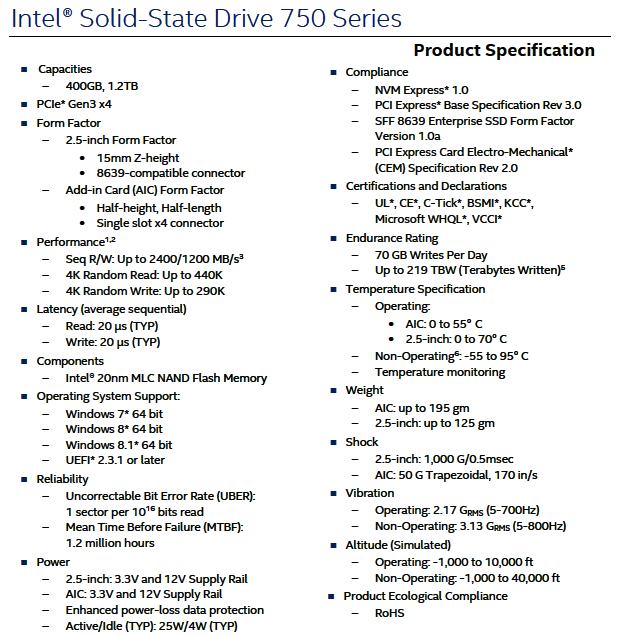Intel SSD 750 Series Introduction And Specifications
We've historically been big on PCI Express SSDs here, because they get around the SATA bottleneck that holds many standard 2.5-inch SATA Solid State Drives down at around 550MB/sec max throughput. PCIe SSDs are able to utilize full PCIe X4 or X8 Gen 2 or Gen 3 bandwidth, hitting speeds well in excess of 1GB/sec in many cases. Still, though laying Flash memory down on a PCIe card has its advantages, many of the solutions currently on the market, save for some high-end, expensive offerings from the likes of Fusion-io, actually still utilize SATA controllers on their backend interface to the Flash memory, usually in a multi-controller RAID setup, that then has to be bridged to PCI Express on the other side.
In short, though this design approach does effectively get past the SATA bottleneck, bridging and translation from one serial interface to another like this, adds latency and nips at overall throughput. However, more recently, major manufacturers have been collaborating on the NVMe or NVM Express interface that was designed to offer direct high speed serial interfaces for NAND Flash Non-Volatile Memory (or NVM) natively over PCI Express. Essentially, an NVMe controller offers an optimized, dedicated interface for Flash to connect to the PCI Express links in a system. The NVMe standards consortium consists of companies like Micron, Seagate, SanDisk, Samsung, PMC, Cisco, EMC, Dell and of course, Intel.
Update 9/23/15: Since the time of this publication, Intel has launched yet another data center class NVMe PCI Express solid state drive, dubbed the SSD DC P3608. In a nutshell, this SSD is essentially two SSD 750 drives packed on to a single PCB with software RAID and offering a blistering 5GB/sec read throughput as well, as two times the write throughput of about 3GB/sec. Again, the difference here is that this particular drive is designed for high endurance in the data center and as such is over-provisioned with excess NAND capacity for wear leveling and also employs Intel's HET (High Endurance Technology) MLC NAND Flash memory. If you're in the need of killer performance and reliability in enterprise or high-end workstation applications, head on over to check it out.
Today, the company's SSD 750 Series brings this cutting-edge NVMe technology down to the more mainstream performance/enthusiast market. We've got a beefy 1.2 Terabyte PCIe card on hand to show you what it's made of and how it performs.
|

Find the Intel SSD 750 Series NVMe PCIe SSD At Amazon - 400GB at $389, 1.2TB at $1029

We should also note the the SSD 750 Series comes with a 5 year limited warranty and its endurance is rated for 70GB of writes per day, with a total of 219TB written and a 1.2 million hour MTBF or meantime between failures. Comparably, drives like the RevoDrive 350 are rated for 50GB writes per day, although, in contrast, Intel's enterprise-targeted SSD DC P3700 is rated for a whopping 36.5 total PBW or petabytes written.






